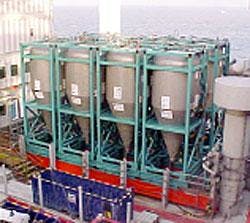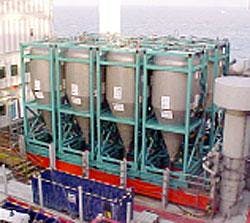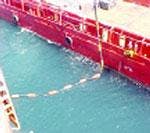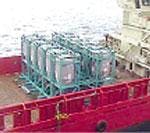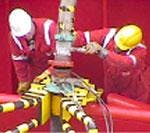Air-pressure transfer solves contaminated cuttings problem
Frank Krukowski
M-I/Swaco
Richard Bingham
Gordon Logan
CleanCut
Regulatory changes in the North Sea have reduced the allowable level of discharge of residual hydrocarbons on drill cuttings to 1% by weight. This has resulted in cuttings either being injected in slurry form or transferred to shore for processing. Transporting drill cuttings to shore has also increased in other areas of the world.
Transfer has largely been by specially constructed cuttings boxes. Experiences arising from skip filling and handling operations identified a requirement for new bulk techniques for the safe containment and transport of drill cuttings.
A bulk transfer and containment method for drill cuttings based on the use of positive air pressure conveying has been under development since 1998. Initial onshore trials proved the capability to convey drill cuttings samples. A product development program to adapt this technology to the specific demands of oilfield drilling was then undertaken. In autumn 2000, on-rig containment and rig-to-boat transfer trials were carried out on rigs drilling in UK waters.
Legislation policies
After Jan. 16, 2001, the offshore discharge of cuttings contaminated with greater than 1% residual hydrocarbons on cuttings was prohibited in UK waters. Rules have been tightening worldwide, with similar discharge regimes implemented in all western European waters, the Caspian Sea, and other areas. In the US, discharge regulations now require either containment of contaminated cuttings or drying below 6.9% retention on cuttings for base fluids that meet the environmental performance criteria for IO 1618, or 9.4% retention on cuttings for base fluids that meet the environmental performance criteria of esters. Improved methods for moving cuttings either to containment, to process before discharge, or to cuttings re-injection units are required.
While the established solution for containing cuttings offshore - "skip and ship" - is technically proven, it can be troublesome. Boxes are filled with material on the rig and transferred one at a time to an adjacent supply vessel. Very large numbers of crane lifts are required offshore, which requires a strong focus on safety management. The number of skips involved creates significant logistic management challenges. Operations may also be affected by weather.
A system that could move contaminated cuttings in a sealed system by bulk transfer from rig to boat would eliminate these risks. Several possible technology options exist for the bulk transfer of materials.
Mechanical systems such as augers, conveyor belts, and bucket conveyors are not suitable for rig-to-boat transfer because of the distances and relative motion involved, as well as the difficulty of ensuring total containment.
Slurry-pumping technology is capable of covering the distances involved and has previously been utilized in the oilfield to convey cuttings short distances. The principle of slurry-based systems is adding fluid and mixing to suspend the solids in a liquid mixture that can be pumped. The addition of fluid obviously increases the size of the waste stream, and may complicate subsequent processing.
Vacuum-conveying technology, which uses an exhauster unit to create a pressure differential and sucks material along a hose or pipeline in a low material/air ratio, may be used successfully to convey cuttings short distances, but is not suitable for moving drill cuttings from rig to boat at a sufficient rate over the distances required.
Positive air pressure conveying, which uses compressed air to push granular materials through pipes or hoses with a high ratio of material to air, is widely used in industrial settings, including coal-fired electricity generation, found-ries, and iron and steel works. The potential to use positive air pressure conveying technology to move drill cuttings was first identified in 1998.
Development of the system
The primary objective of the design and development program was a system that could fully contain and handle drill cuttings contaminated with invert emulsion mud all the way from the shaker ditch to the point of processing or final disposal onshore. The technology had to be safe, reliable, and able to handle untreated cuttings at the rate they were produced. Interim storage capability on rigs and supply vessels would be required, and bulk-transfer capability at rates acceptable to overall well logistics was necessary.
The first phase of the development program was onshore testing, which began in 1998. Initial material tests were carried out in the controlled environment of the manufacturer's in-house testing facility, enabling development of the design concepts. The basic concepts were then tested and proven at an onshore cuttings processing site in Lowestoft, England. Two major oil companies were invited to participate and all equipment was tested successfully onshore before offshore trials began. Various samples of drill cuttings from different wells were used in these onshore tests, which took place in 1999 and 2000.
ISO pumps
The cuttings-handling system begins when drill cuttings contaminated with hydrocarbons exit the shaker ditch and are fed into a hopper above a cuttings blower unit. When the hopper reaches a preset level, the material enters the cuttings blower and is dispatched to combined storage and conveying units located elsewhere on the rig. Each of these units, referred to as ISO (International Standards Organization) Pumps, can store 20-25 cu m of cuttings, depending on bulk density. The combined storage and conveying units are used for on-rig storage of cuttings until the supply vessel comes alongside.
The cuttings are then discharged through a flexible hose to identical units mounted on the deck of the supply vessel. When the supply vessel returns to harbor, the loaded units on board may be discharged to onshore vehicles, to storage, or discharged directly into a harbor-side processing facility. Alternatively, the units may be lifted directly from the vessel for road transport to a cuttings-processing facility.
Manpower requirements to operate the on-rig equipment consist of one to two dedicated men per shift, depending on the phase of the well. Other than the crane lifts for the hose, there is no requirement for the use of the rig crew in operating the system.
Offshore testing began in 2000 on a semisubmersible rig West of Shetland. A blower unit successfully conveyed cuttings at rates of up to 25 m/hr over distances of 240 ft and to heights of 40 ft. An ISO-Pump unit was successfully filled and discharged after 24 hr settling, and conventional cuttings boxes were filled without difficulty. The equipment operated safely with no reported incidents and no health and safety concerns noted.
Further trials took place later that year on another semisubmersible with a second operator. The most significant of these was the world's first pneumatic transfer of drill cuttings from a rig to a supply vessel. In the Sept. 23, 2000, trial, a cuttings blower filled an ISO-Pump on the rig with 20 tons of cuttings. This ISO-Pump was then discharged via a flexible hose at a distance of over 61 m to an ISO-Pump on a supply boat alongside the rig. The material was discharged at a rate of 40 t/hr without problems.
Full-scale bulk transfer
The first full-scale bulk transfer trial took place in June 2001. The objective of the trial was to clearly demonstrate the capability to convey drill cuttings from their production at the shale shakers through three stages of handling, finally resulting in transfer of the cuttings from a platform supply vessel to a storage and processing facility onshore at Lerwick, Shetland.
The trial was a combination of three separate material handling stages:
- Collection and conveying of the drill cuttings from the shale shakers by a cuttings blower to ISO-Pump vessels located on the rig, which provided intermediate storage
- Conveying the drill cuttings from the rig ISO-Pumps to an equal number of ISO-Pumps onboard
- Discharge of the PSV-located ISO-Pumps into storage containers on the quayside for subsequent processing.
Conveying equipment onboard
The rig used for the trials was a deepwater semisubmersible operating West of Shetland. The conveying equipment onboard included a cuttings blower, five ISO-Pumps, four material valves, and associated conveying pipe.
The cuttings blower was the primary mover, transporting the cuttings in a closed 5-in. nominal bore conveying pipeline through to the storage ISO-Pumps located on the starboard riser deck. A conveying distance of 131 ft was recorded between the cuttings blower and rig ISO-Pumps.
All of the conveying pipe was 5-in. nominal bore pipe galvanized to reduce corrosion and maintain a uniform internal surface finish.
The five ISO-Pumps were all mounted on weigh frames to enable monitoring of the actual weight of cuttings produced and handled by the system.
The conveying distance from rig to PSV ISO-Pumps was 394 ft, with 177 ft of 5-in. hard walled, high-pressure hose, and the balance flexible hose with the same nominal bore. The hose was made up from 60-ft lengths connected with fittings.
Tilt table
To make the hook-up between the PSV and the rig without manually lifting the 5-in. hose, a purpose-designed assembly was manufactured and installed on the PSV. The assembly, known as a tilt table, offers a simple, quick and safe solution to this challenge.
On June 22, 2001, several days before the actual drilling activities began, a trial was held to demonstrate the functionality of the tilt table. The PSV was brought alongside the port side of the rig and the hose lowered. The tilt table was used to engage and disengage the hose. Both stages were done to the satisfaction of all parties. The PSV then repositioned to the standoff area.
All partipants judged the loading and discharge of the rig ISO-Pumps as very successful. The average discharge rate of 20 t/hr from rig to boat (68 bbl/hr) was below the anticipated level. Potential pipe route modifications were identified to improve on this value for subsequent projects. The tilt-table operations demonstrated the capability to make hose connections to the PSV without the need for manual handling.
The discharge of the four boat ISO-Pumps to shore reception was conducted with no opera-tional or health, safety, or environmental concerns. The ISO-Pumps were operated in stop/start mode to enable the discharge hood to be repositioned over empty containers as the discharge progressed.
An average discharge rate of 35 t/hr was recorded for a volume of drill cuttings that was analyzed as having an oil-on-cuttings value of 7%.
The cuttings had an angle of repose of 60-70°. Consequently, the cuttings built up in the onshore reception container beneath the discharge hood, resulting in poor distribution along the container's full 20-ft length. The need was identified for an improved discharge arrangement to achieve a larger working capacity from each container.
Monitoring of the air in the discharge area for volatile organic carcinogens found there to be no measurable emissions.
Conclusion
Positive air pressure bulk-transfer technology has been applied to solve the problem of bulk transfer of drill cuttings. Full-scale bulk-transfer systems have been successfully fitted to rigs and to PSVs. Oil based mud cuttings with varying characteristics have been safely and successfully transported to shore reception facilities. Average transfer rates of 20 to 43 t/hr were recorded.
With the UK installation, fewer rig personnel were required to operate the equipment, crane operations were reduced to a handful of hose lifts, and the contaminated materials were kept within a sealed system until discharged into onshore reception tanks. Health, safety, and environmental risks were greatly reduced.
The Gulf of Mexico installation demonstrated the flexibility of the conveying technology in transferring cuttings from the shaker ditch to a series of different locations on the PSV, successfully keeping pace with a 17 1/2-in. section. The potential to use the cuttings blower to feed cuttings dryers, re-injection units, or other containment units was identified. It can be concluded that this technology is a significant advance in drill cuttings handling and will assist significantly in the quest to minimize the environmental impact of offshore drilling operations.
The cuttings are discharged through a flexible hose to identical units mounted on the deck of the supply vessel.
When the supply vessel returns to harbor, the loaded units on board may be discharged to onshore vehicles, to storage, or discharged directly into a harbor-side processing facility.
To make the hook-up between the PSV and the rig without the need for manual lifting of the 5-in. hose, a purpose-designed assembly, or tilt table, was manufactured and installed on the PSV.
